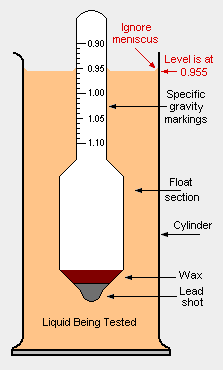User:Milton Beychok/Sandbox: Difference between revisions
imported>Milton Beychok (→Scales) |
imported>Milton Beychok No edit summary |
||
| Line 9: | Line 9: | ||
The many hydrometer scales that are commonly used include: | The many hydrometer scales that are commonly used include: | ||
;[[Specific gravity]]:This scale is widely used in [[chemistry]], [[engineering]]and [[physics]] ... and is the one shown in the adjacent drawing. It is expressed as: | ;[[Specific gravity]]: This scale is widely used in [[chemistry]], [[engineering]] and [[physics]] ... and is the one shown in the adjacent drawing. It is expressed as: | ||
:<math>\mathrm{SG}_{4\,^\circ \mathrm{C}}^{4\,^\circ \mathrm{C}} = \frac {\mathrm{density\; of\; the\; tested\; liquid\; at\; 4\,^\circ \mathrm{C}}} {\mathrm{density\; of\; water\; at\; 4\,^\circ \mathrm{C}}}</math> | :<math>\mathrm{SG}_{4\,^\circ \mathrm{C}}^{4\,^\circ \mathrm{C}} = \frac {\mathrm{density\; of\; the\; tested\; liquid\; at\; 4\,^\circ \mathrm{C}}} {\mathrm{density\; of\; water\; at\; 4\,^\circ \mathrm{C}}}</math> | ||
| Line 15: | Line 15: | ||
:Unless the two reference temperatures are explicitly stated, they are generally taken to be 4 [[Celsius (unit)|°C]]. | :Unless the two reference temperatures are explicitly stated, they are generally taken to be 4 [[Celsius (unit)|°C]]. | ||
;[[API gravity]]: This scale was developed by the [[American Petroleum Institute]] (API) in 1921 for use in | ;[[API gravity]]: This scale was developed by the [[American Petroleum Institute]] (API) in 1921 for use in the petroleum industry. It is expressed as: | ||
:<math>^\circ \mathrm{API} = \frac{141.5}{\mathrm{SG}_{60\,^\circ \mathrm{F}}^{60\,^\circ \mathrm{F}}} - \mathrm{131.5}</math> and <math>\mathrm{SG}_{60\,^\circ \mathrm{F}}^{60\,^\circ \mathrm{F}} = \frac {\mathrm{density\; of\; petroleum\; liquid\; at\; 60\,^\circ \mathrm{F}}} {\mathrm{density\; of\; water\; at\; 60\,^\circ \mathrm{F}}}</math> | :<math>^\circ \mathrm{API} = \frac{141.5}{\mathrm{SG}_{60\,^\circ \mathrm{F}}^{60\,^\circ \mathrm{F}}} - \mathrm{131.5}</math> and <math>\mathrm{SG}_{60\,^\circ \mathrm{F}}^{60\,^\circ \mathrm{F}} = \frac {\mathrm{density\; of\; petroleum\; liquid\; at\; 60\,^\circ \mathrm{F}}} {\mathrm{density\; of\; water\; at\; 60\,^\circ \mathrm{F}}}</math> | ||
| Line 21: | Line 21: | ||
:Note: 60 [[Fahrenheit (unit)|°F]] is equivalent to 15.56 °C. | :Note: 60 [[Fahrenheit (unit)|°F]] is equivalent to 15.56 °C. | ||
;[[Baumé gravity]] | ;[[Baumé gravity]]: These two scales, one for liquids lighter than water and one for liquids heavier than water, was developed by the [[France|French]] chemist [[Antoine Baumé]] in 1768 and they are expressed as: | ||
:<math>^\circ \mathrm{B\acute{e}} = \frac{140}{\mathrm{SG}_{20\,^\circ \mathrm{C}}^{20\,^\circ \mathrm{C}}} - \mathrm{130}</math> (for liquids lighter than water) and <math>\mathrm{SG}_{20\,^\circ \mathrm{C}}^{20\,^\circ \mathrm{C}} = \frac {\mathrm{density\; of\; the\; tested\; liquid\; at\; 20\,^\circ \mathrm{C}}} {\mathrm{density\; of\; water\; at\; 20\,^\circ \mathrm{C}}}</math> | |||
:<math>^\circ \mathrm{B\acute{e}} = \mathrm{145} - \frac{145} {\mathrm{SG}_{20\,^\circ \mathrm{C}}^{20\,^\circ \mathrm{C}}}</math> (for liquids heavier than water) and <math>\mathrm{SG}_{20\,^\circ \mathrm{C}}^{20\,^\circ \mathrm{C}} = \frac {\mathrm{density\; of\; the\; tested\; liquid\; at\; 20\,^\circ \mathrm{C}}} {\mathrm{density\; of\; water\; at\; 20\,^\circ \mathrm{C}}}</math> | :<math>^\circ \mathrm{B\acute{e}} = \mathrm{145} - \frac{145} {\mathrm{SG}_{20\,^\circ \mathrm{C}}^{20\,^\circ \mathrm{C}}}</math> (for liquids heavier than water) and <math>\mathrm{SG}_{20\,^\circ \mathrm{C}}^{20\,^\circ \mathrm{C}} = \frac {\mathrm{density\; of\; the\; tested\; liquid\; at\; 20\,^\circ \mathrm{C}}} {\mathrm{density\; of\; water\; at\; 20\,^\circ \mathrm{C}}}</math> | ||
Revision as of 20:57, 2 February 2010
A hydrometer is an instrument used to measure the specific gravity (or relative density) of liquids; that is, the ratio of the density of the liquid to the density of water with both at the same temperature. It is usually made of glass and consists of a small diameter cylindrical stem and a larger diameter section weighted with mercury or lead shot (sealed with wax) to make it float upright. The larger diameter section is necessary to provide the displacement volume needed for the proper buoyancy of the hydrometer
The stem contains a rolled paper marked with the scale being used. There are a great many different hydrometer scales commonly used to measure liquid densities in: petroleum crude oil marketing and refining; making wine, brewing beer and making whiskey; producing sulfuric acid and other industrial chemicals; and refining sugar.
Scales
The many hydrometer scales that are commonly used include:
- Specific gravity
- This scale is widely used in chemistry, engineering and physics ... and is the one shown in the adjacent drawing. It is expressed as:
- Unless the two reference temperatures are explicitly stated, they are generally taken to be 4 °C.
- API gravity
- This scale was developed by the American Petroleum Institute (API) in 1921 for use in the petroleum industry. It is expressed as:
- and
- Note: 60 °F is equivalent to 15.56 °C.
- Baumé gravity
- These two scales, one for liquids lighter than water and one for liquids heavier than water, was developed by the French chemist Antoine Baumé in 1768 and they are expressed as:
- (for liquids lighter than water) and
- (for liquids heavier than water) and
History
Knowledge of relative density or specific gravity has been with us since the days of Archimedes in 250 BC, with the observation that light objects can float while heavier ones will sink in water.[1] Availa Hypatia (born ca. 350 and died 415 AD), a Greek scholar from Alexandria in Egypt, is reputed to have invented the hydrometer.[2]
References
- ↑ T. L. Heath (1897). The Works of Archimedes. Cambridge University Press, page 253. Full text available at www.archive.org
- ↑ Mothers of Invention Ethlie Ann Vare and Greg Ptacek, 1988, pp. 24-26.






